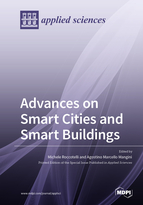Advances on Smart Cities and Smart Buildings
A special issue of Applied Sciences (ISSN 2076-3417). This special issue belongs to the section "Environmental Sciences".
Deadline for manuscript submissions: closed (20 November 2021) | Viewed by 36044
Special Issue Editors
Interests: smart grids; smart buildings; smart mobility; optimization and control methods
Special Issues, Collections and Topics in MDPI journals
Interests: smart buildings; smart grids; intelligent transportation systems; Petri nets; optimization; autonomous vehicles
Special Issues, Collections and Topics in MDPI journals
Special Issue Information
Dear Colleagues,
Modern cities are facing the challenge of combining competitiveness on a global city scale and sustainable urban development to become smart cities. A smart city is a high-tech intensive and advanced city that connects people, information, and city elements using new technologies in order to create a sustainable, greener city, competitive and innovative commerce, and an increased quality of life. In recent years, in the smart city context, smart and green building management has become one of the main challenges for automation and building construction. In addition to the utilization of renewable energy resources, the necessity to ensure both high-level comfort and energy efficiency can be satisfied by adopting new suitable and intelligent building energy management systems (BEMSs) to be integrated in building automation control systems. In this context, the main challenge is to minimize energy consumption, guaranteeing a high level of indoor comfort conditions in buildings, which generally depends on three factors: thermal comfort, visual comfort, and air quality comfort. To this purpose, novel models, algorithms, and tools can be proposed to maximize the indoor life quality with the minimum energy consumption both via active “energy consuming” systems (e.g., HVAC) and passive strategies (e.g., natural ventilation).
Dr. Michele Roccotelli
Prof. Dr. Agostino Marcello Mangini
Guest Editors
Manuscript Submission Information
Manuscripts should be submitted online at www.mdpi.com by registering and logging in to this website. Once you are registered, click here to go to the submission form. Manuscripts can be submitted until the deadline. All submissions that pass pre-check are peer-reviewed. Accepted papers will be published continuously in the journal (as soon as accepted) and will be listed together on the special issue website. Research articles, review articles as well as short communications are invited. For planned papers, a title and short abstract (about 100 words) can be sent to the Editorial Office for announcement on this website.
Submitted manuscripts should not have been published previously, nor be under consideration for publication elsewhere (except conference proceedings papers). All manuscripts are thoroughly refereed through a single-blind peer-review process. A guide for authors and other relevant information for submission of manuscripts is available on the Instructions for Authors page. Applied Sciences is an international peer-reviewed open access semimonthly journal published by MDPI.
Please visit the Instructions for Authors page before submitting a manuscript. The Article Processing Charge (APC) for publication in this open access journal is 2400 CHF (Swiss Francs). Submitted papers should be well formatted and use good English. Authors may use MDPI's English editing service prior to publication or during author revisions.
Keywords
- smart buildings
- building energy management system
- near-zero energy buildings (NZEB)
- smart grids
- intelligent power and energy systems
- smart urban environments
- intelligent transportation systems
- green mobility
- autonomous vehicles and smart cities






